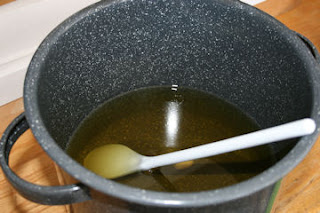Most of my oils come in 5 gallon buckets. I drive down to the Lancaster area to get these.
I usually make 4 batches at a time, each in one of these pots, it is easier to measure out 4 at a time, instead of trying to haul buckets around for each batch.
My trusty little scale has served me well. Most of my measurements are by grams.
Some of the oils start out as liquid and some are solid, once into the pot, they all melt together.

Once the oils are on their way to melting, i begin the lye process. I store my goat milk in the freezer in pre-measured amounts. I also label the milk with who it is from, this batch is from Flo, and when I milked her.
I keep the milk in the sink in a cold water bath. This keeps the temperature down so the milk wont scald. This is where it gets tricky with goat milk soap, normally without the GM, I wouldn't really care about temperature, but it is very easy for the milk to curdle and turn all sorts of nasty colors and smells.
Keeping the mixture in the sink is also a safety issue, once I start adding they lye, it becomes very caustic and can be dangerous.
It usually takes between 15-30 minutes to add the lye to the milk. Once this is done and the oil is at the right temp, it is time to mix the two together. This is when the magic happens.
The mixture begins to saponify, a fancy word for blending. Well it is actually the chemical process that changes the oil and lye into soap. Stick blenders are a great tool, it cuts down the mixing time, it also ensures that everything is blended completely. I mix until I reach lite trace, when the mixture begins to thicken up. At this point I add the scent and botanicals if needed.
Once these are added, into the mold it goes. I use wooden molds lined with freezer paper.
The soap sets in the mold for 24 hours, it continues to change. After 24 hours, I unmold it and cut it into individual bars.
Finally, the soap goes into drying racks, where it will cure for 4 weeks.
This allows the moisture to evaporate out, leaving a hard bar of wonderfulness behind.
And that is how I make soap. (well the non secret portions anyway.)












That is so cool - well, the whole thing is cool, but I love the bit about labeling the milk with who it's from!
ReplyDeleteHeidi - I'm so glad I found your blog! This is the best 'how-to' on goat's milk soap I have seen. I am working my way through your archives. I am getting an angora doeling this spring, as well as a Nigerian Dwarf doeling and whether, with the hopes of having goat milk next year. I keep a Jersey heifer at a neighbor's who is due to freshen within a week. I should be up to my elbows in milk - glorious! Waiting, like you, for this endless winter to stop and let spring in.
ReplyDeleteLorena and Susan, I am so bad (obviously) about checking comments. Nothing like a year later. Thanks, both of you for reading.
ReplyDelete